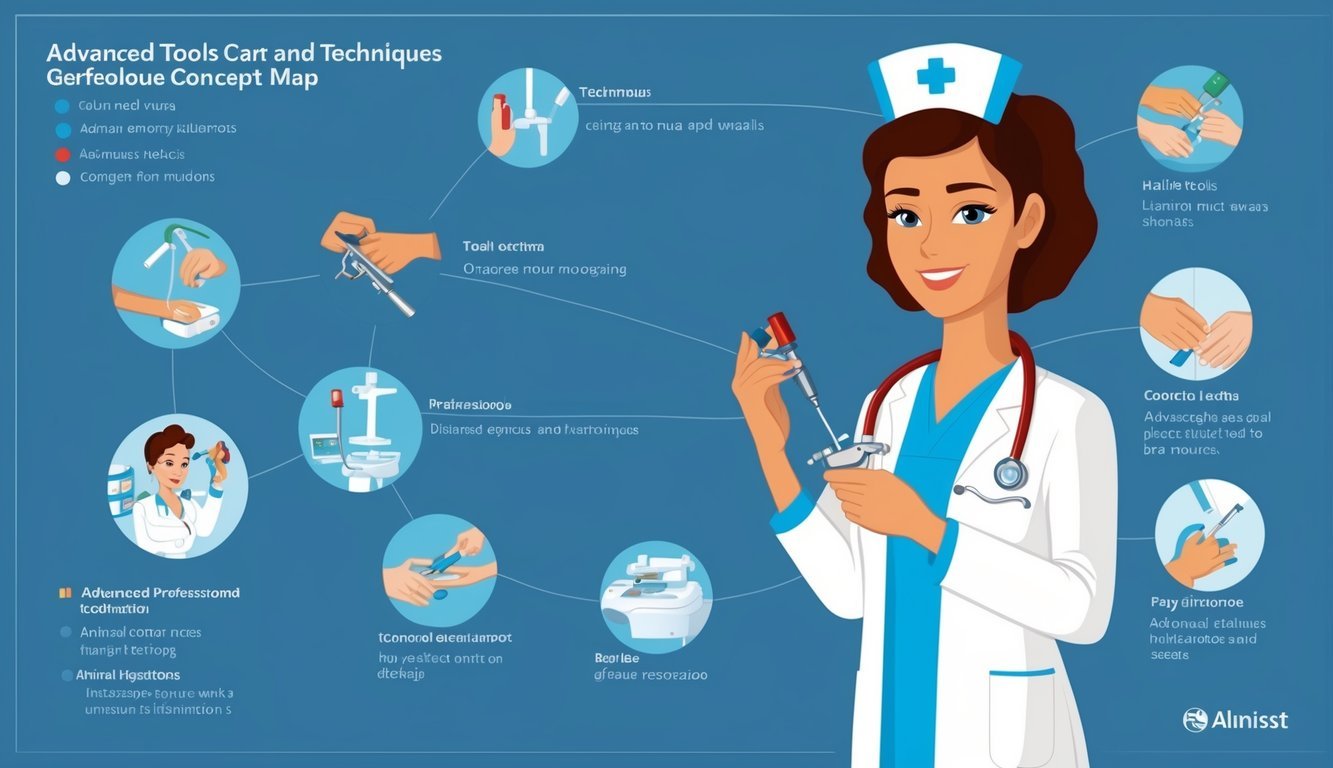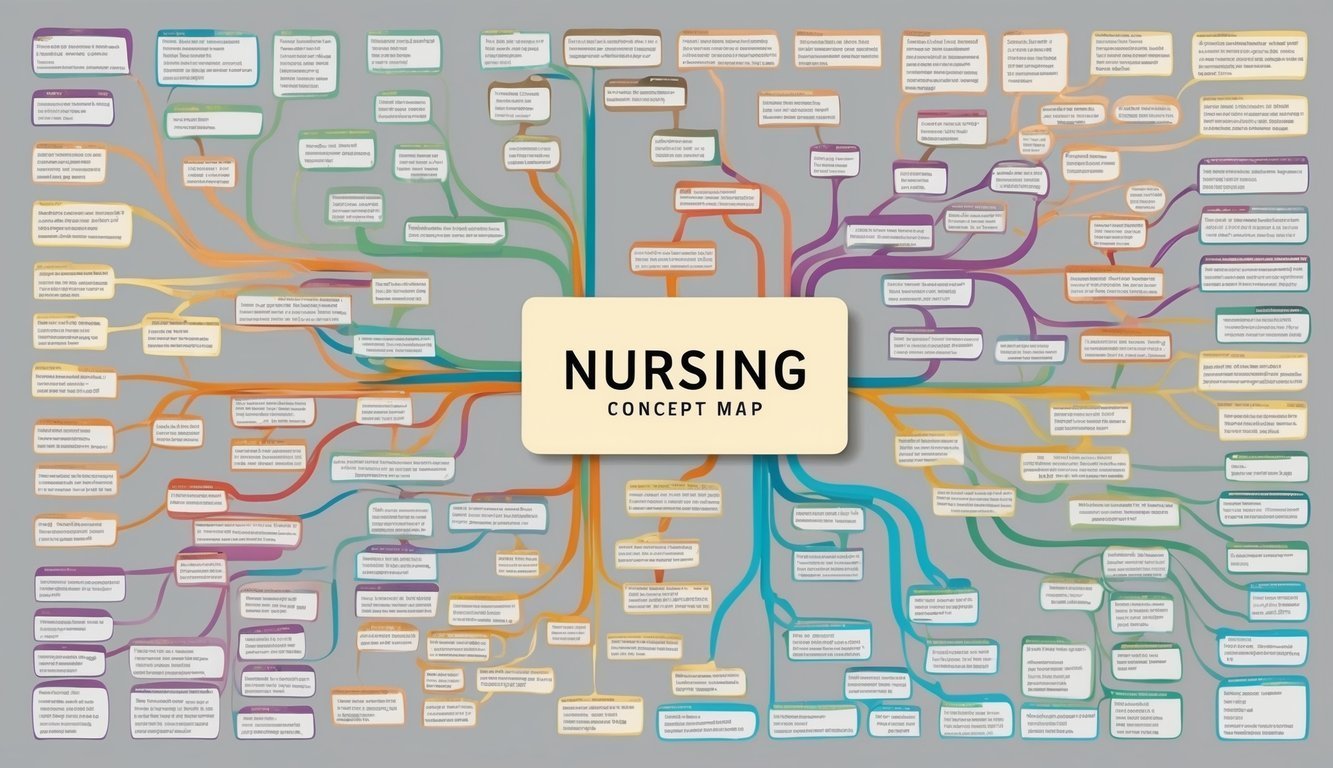In the nursing profession, you need to organize and visualize patient data for effective care.
A concept map in nursing serves as a powerful visual tool.
It allows you to connect various aspects of patient information, enhancing critical thinking and comprehension.
This method not only helps you strategize individual patient care plans but also reinforces your learning and retention of complex medical concepts.
By utilizing nursing concept maps, you can systematically layout assessments, diagnoses, and interventions.
These maps encourage a holistic view of the patient, breaking down information into manageable parts while illustrating how different concepts interlink.
As you work through patient scenarios, you’ll find that this approach aids in decision-making and promotes a deeper understanding of nursing responsibilities.
For those looking to streamline their study and practice, exploring examples of nursing concept maps can be invaluable.
Resources like Nurse.org provide templates and guidance to help you create effective maps tailored to your learning needs.
Engaging with these tools can transform your approach to patient care and enhance your overall nursing education.
Foundations of Concept Mapping in Nursing
Concept mapping serves as a crucial tool in nursing education, facilitating clearer understanding and organization of patient care concepts.
It enables you to visualize relationships and develop critical thinking skills essential for effective practice.
Understanding Concept Maps
Concept maps are visual representations that illustrate the connections between various nursing concepts and patient care aspects.
They allow you to organize information logically, making complex data more manageable.
By utilizing nodes to represent concepts and lines to depict relationships, you can clarify how different factors influence patient outcomes.
This technique enhances comprehension of intricate nursing topics.
Benefits of Concept Maps for Nursing Students
Concept maps offer numerous advantages for nursing students:
- Improved Critical Thinking: Engaging in concept mapping enhances your ability to analyze and synthesize information, crucial for clinical decision-making.
- Enhanced Retention: Visual tools aid memory retention, helping you recall vital concepts during exams and practice.
- Organized Learning: They promote clarity by structuring information systematically, making it easier to identify gaps in knowledge.
Studies have shown that using concept maps can improve learning outcomes and confidence in nursing students.
Types of Concept Maps Used in Nursing Education
Various types of concept maps are employed in nursing education, each serving unique purposes:
| Type | Description |
|---|---|
| Spider Maps | Useful for brainstorming, spider maps allow you to start with a central idea and expand. |
| Hierarchical Maps | These maps organize information in a top-down fashion, ideal for outlining patient care plans. |
| Flow Charts | Flow charts visually represent processes, helping you understand steps in patient care. |
| System Maps | Helpful for viewing interconnected systems, these maps illustrate how various factors impact health. |
Utilizing the appropriate type of concept map can enhance your learning experience and assist you in clinical settings, making them an essential part of nursing education.
For further insights, you can explore resources like those provided by Simple Nursing and Nurse.org.
Creating a Nursing Concept Map
Creating a nursing concept map is an essential skill for effectively organizing and visualizing complex patient care data.
It allows you to clearly see relationships between various nursing concepts, helping enhance your understanding and decision-making.
Components of a Nursing Concept Map
A nursing concept map typically consists of several key components:
- Nursing Diagnoses: These are critical for identifying patient needs based on assessment data.
- Patient Assessment Data: This includes observations, lab results, and patient history that inform the nursing process.
- Nursing Interventions: Specific actions taken to address the identified nursing diagnoses.
- Expected Outcomes: Goals set for patient care to measure the effectiveness of interventions.
- Evaluation Criteria: These criteria are used to assess whether the expected outcomes have been achieved.
Each of these components visually connects to provide a comprehensive overview of patient care.
Steps to Develop a Nursing Concept Map
To create an effective nursing concept map, follow these steps:
- Identify the Main Concept: Begin by determining the central topic you want to map.
- Gather Relevant Data: Compile patient assessment data, nursing diagnoses, and expected outcomes. Use concise notes.
- Organize Information: Arrange the gathered data in a logical order, using a visual model that suits your understanding. This can include flowcharts, spider maps, or hierarchical charts.
- Connect Components: Draw lines or arrows to illustrate relationships between different elements, such as how nursing interventions address specific diagnoses.
- Review and Revise: Ensure clarity and accuracy by reviewing your map. Make adjustments as needed for better understanding.
Following these steps will facilitate a clearer understanding of patient care.
Choosing the Right Template
Selecting an appropriate nursing concept map template can enhance your workflow.
Consider the following types:
| Template Type | Description |
|---|---|
| Spider Map | Central idea in the middle with branches for related concepts. Useful for brainstorming. |
| Flowchart | Step-by-step process to visualize decision-making and patient pathways. |
| Hierarchical Map | Top-down structure showing the relationship between primary and secondary concepts. |
Many resources offer free templates for nursing concept maps.
Explore options on websites like Nurseship for tools that can simplify your mapping process.
Choose a template that best fits your learning style and the complexity of the information.
Integrating Clinical Data and Critical Thinking
Integrating clinical data with critical thinking is essential for effective nursing practice.
This involves using patient information to inform your decisions, enhance clinical judgment, and ensure comprehensive care.
Focused assessment and analytical skills enable you to manage risk factors and anticipate complications effectively.
Incorporating Patient Assessment and Data
Accurate patient assessment is fundamental in nursing.
You collect vital information such as vital signs, medical history, and presenting symptoms to build a complete picture of the patient’s condition.
Utilizing tools like concept maps can help synthesize this data visually.
For instance, consider the following patient data points:
| Data Point | Example |
|---|---|
| Medical Diagnosis | Hypertension |
| Risk Factors | Obesity, Family History |
| Complications | Stroke, Heart Failure |
By integrating these elements, you can identify potential complications and devise appropriate interventions.
Application of Critical Thinking Skills
Critical thinking skills are crucial in analyzing and interpreting patient data.
You must evaluate clinical information to make informed decisions.
This includes distinguishing between relevant and irrelevant data.
Employ strategies such as:
- Reflection: Analyze past experiences to inform current decisions.
- Analysis: Break down complex information into manageable parts.
- Evaluation: Assess the credibility of sources and how they apply to the patient’s situation.
These skills enhance your ability to identify complications and prioritize patient needs effectively.
Clinical Judgment and Decision-Making
Clinical judgment is the culmination of your assessments, critical thinking, and knowledge.
It allows you to make decisions about patient care based on data analysis and risk assessment.
Key aspects include:
- Risk Factors: Identifying patient-specific factors that may influence outcomes.
- Complications: Monitoring for signs of adverse events based on the clinical data.
Utilizing concept mapping can visually represent relationships between various factors, helping you foresee complications and make timely interventions.
This logical approach ensures that your decisions align with best practices and patient-centered care.
Nursing Concept Map in Patient Care Planning
Nursing concept maps play a pivotal role in organizing and strategizing patient care plans.
These visual tools help you connect various elements necessary for effective patient management, facilitating clearer communication and improved patient outcomes.
Developing a Patient Care Plan
When creating a patient care plan, begin by identifying the patient’s primary needs.
Collect data through assessments, which may include physical examinations and patient history.
Organize this information into a format that highlights key concerns, such as diagnosis and objectives.
You can use a nursing concept map to encapsulate these elements visually.
Elements to include are:
- Assessment: Collect data on the patient’s current health status.
- Diagnosis: Identify the health problems.
- Goals: Set measurable objectives for patient outcomes.
- Interventions: Plan actions to address the goals.
- Evaluation: Review patient responses and update the plan accordingly.
This structured approach enhances both your understanding and strategic planning.
Nursing Care Plan Concept Map
The nursing care plan concept map integrates patient data with nursing interventions.
This map can visually depict the relationship between problems, goals, and anticipated interventions.
You can utilize specific templates that allow you to categorize patient needs and interventions effectively.
For example, you might create sections for:
- Patient Problems: Identify key issues.
- Nursing Interventions: Outline steps to address problems.
- Expected Outcomes: Establish what success looks like for the patient.
By employing this visual aid, you can better communicate your plan to other healthcare professionals, ensuring continuity and coordination of care.
Prevention of Infection and Patient Education
Infection prevention is crucial in patient care.
Integrate education into your nursing concept map to address this effectively.
You should focus on practices such as hand hygiene, use of personal protective equipment (PPE), and proper wound care.
Key educational points may include:
- Hand Hygiene: Emphasize the importance of handwashing.
- Use of PPE: Instruct on when and how to use protective gear.
- Patient Awareness: Teach patients about recognizing signs of infection.
By including these elements in your care plan, you empower patients to take an active role in their health, ultimately enhancing their outcomes.
You can also access helpful resources on nurse.org for more on effective nursing concept maps.
Advanced Techniques and Tools

In nursing education, utilizing advanced techniques and tools can significantly enhance your ability to create effective concept maps.
Leveraging technology and structured communication methods can streamline your processes and improve patient care strategies.
Leveraging Technology for Concept Mapping
Technology plays a pivotal role in creating concept maps.
Tools such as Mind Mapping software, Microsoft Word, and various graphic organizers enable you to visualize complex nursing concepts effectively.
- Mind Maps offer a flexible way to arrange information. You can create branches for subtopics like assessments or interventions.
- Microsoft Word can also be used creatively to design tables and diagrams to organize patient care data.
- Graphic Organizers provide structured formats for visualizing patient information, facilitating deeper understanding.
Incorporating timelines and Venn diagrams can also help illustrate the chronological aspects of patient history or compare different care approaches.
Explore online resources for templates that suit your needs.
SBAR as a Structured Communication Tool
Another essential technique is the SBAR (Situation, Background, Assessment, Recommendation) model.
This framework enhances communication among healthcare professionals, ensuring they convey critical patient information clearly.
- Situation: State the current issue or concern regarding the patient.
- Background: Provide relevant patient history or context that informs the situation.
- Assessment: Give your evaluation of the patient’s condition based on your observations.
- Recommendation: Suggest actions or interventions based on the assessment.
Using an SBAR concept map can reinforce concise communication by organizing these elements visually.
This structured approach minimizes misunderstandings and fosters collaboration among caregivers, ultimately leading to improved patient outcomes.
For additional tools and templates, consider visiting resources dedicated to nursing education.

